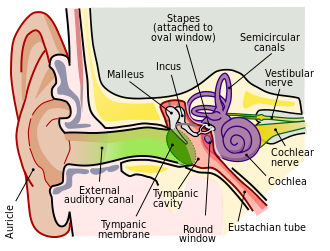Perception: Difference between revisions
No edit summary |
No edit summary |
||
| Line 1: | Line 1: | ||
[[File:Multistability.svg|Multistability|thumb]] | [[File:Multistability.svg|Multistability|thumb]] | ||
[[File:Synthesizing_3D_Shapes_via_Modeling_Multi-View_Depth_Maps_and_Silhouettes_With_Deep_Generative_Networks.png|Synthesizing 3D Shapes | [[File:Synthesizing_3D_Shapes_via_Modeling_Multi-View_Depth_Maps_and_Silhouettes_With_Deep_Generative_Networks.png|Synthesizing 3D Shapes|thumb]] | ||
[[File:Cerebrum_lobes.png|Cerebrum Lobes|left|thumb]] | [[File:Cerebrum_lobes.png|Cerebrum Lobes|left|thumb]] | ||
[[File:Anatomy_of_the_Human_Ear_en.svg|Anatomy of the Human Ear|thumb]] | [[File:Anatomy_of_the_Human_Ear_en.svg|Anatomy of the Human Ear|thumb]] | ||
Latest revision as of 01:42, 20 March 2025






Process of interpreting sensory information
Perception is the process by which organisms interpret and organize sensory information to form a meaningful experience of the world. It involves the transformation of sensory stimuli into neural signals that the brain interprets, allowing individuals to recognize objects, understand speech, sense movement, and respond to environmental cues.
Perception is influenced by both bottom-up processing, which is based on raw sensory input, and top-down processing, which is guided by prior knowledge, experiences, expectations, and cognitive biases. It plays a fundamental role in cognition, decision-making, and behavior.
Sensory Modalities of Perception[edit]
Perception encompasses multiple sensory modalities, each responsible for interpreting different aspects of the environment:
- Vision – Detection of light by the retina and processing in the visual cortex.
- Hearing (Auditory perception) – Interpretation of sound waves detected by the ears.
- Touch (Somatosensation) – Perception of texture, pressure, vibration, and temperature.
- Smell (Olfaction) – Detection of odor molecules by the olfactory system.
- Taste (Gustation) – Recognition of flavors through receptors on the tongue.
- Vestibular system – Sensing balance and spatial orientation.
- Proprioception – Awareness of body position and movement.
- Nociception – Perception of pain as a response to harmful stimuli.
Types of Perception[edit]
Perception is not a passive process but an active construction of reality. It can be divided into two primary processes:
Bottom-Up Processing[edit]
- Driven by external stimuli.
- Begins with basic sensory input (e.g., shapes, sounds, textures).
- Builds into complex recognition (e.g., recognizing a face or an object).
Top-Down Processing[edit]
- Influenced by prior knowledge, expectations, and context.
- The brain applies learned experiences to interpret incoming sensory data.
- Explains why optical illusions and ambiguous stimuli can be perceived differently by different people.
Perception and Reality[edit]
Perception does not always reflect reality accurately. Instead, the brain constructs its own interpretation of sensory input based on:
- Cognitive biases – Pre-existing beliefs influence perception.
- Memory – Past experiences shape how new information is processed.
- Attention – Selective focus determines what we perceive.
- Context – The surrounding environment affects interpretation.
For example:
- Optical illusions demonstrate how the brain fills in missing information or makes incorrect assumptions.
- Auditory illusions (e.g., the McGurk effect) reveal how visual cues influence hearing.
- Synesthesia – A neurological condition where one sense involuntarily triggers another (e.g., associating colors with sounds).
Theories of Perception[edit]
Several psychological and cognitive theories explain how perception functions:
- Gestalt Theory – "The whole is greater than the sum of its parts"; perception organizes stimuli into meaningful wholes.
- Constructivist Theory – Perception is actively constructed from sensory input and prior knowledge.
- Ecological Theory (J.J. Gibson) – Perception is directly influenced by the environment without the need for extensive cognitive processing.
- Bayesian Perception – The brain uses statistical inference to interpret sensory data based on probabilities.
Perception in Different Disciplines[edit]
Perception is a subject of study across multiple disciplines:
Psychology[edit]
- Examines cognitive biases, attention, memory, and sensory integration.
- Investigates perceptual disorders, such as face blindness (prosopagnosia).
Neuroscience[edit]
- Studies neural pathways, sensory processing in the brain, and synaptic connections.
- Uses techniques like fMRI and EEG to analyze perceptual mechanisms.
Cognitive Science[edit]
- Focuses on how the brain interprets and organizes sensory information.
- Explores artificial perception in AI and robotics.
Philosophy[edit]
- Questions the nature of reality vs. subjective perception.
- Explores concepts like phenomenal consciousness and qualia.
Disorders of Perception[edit]
Several neurological and psychological conditions affect perception:
- Agnosia – Inability to recognize objects, sounds, or smells.
- Prosopagnosia – Face blindness, an inability to recognize faces.
- Hallucinations – Perceiving stimuli that are not present (common in schizophrenia and substance use).
- Illusions – Misinterpretation of real sensory stimuli.
- Neglect Syndrome – Failure to perceive one side of the visual field due to brain damage.
Role of Perception in Artificial Intelligence[edit]
Perception is a key challenge in artificial intelligence (AI) and machine learning. AI systems attempt to mimic human sensory processing using:
- Computer Vision – Machines recognizing objects, faces, and patterns.
- Natural Language Processing (NLP) – AI interpreting and generating human language.
- Speech Recognition – AI systems understanding and processing spoken words.
Summary[edit]
Perception is a dynamic cognitive process that enables organisms to interpret their environment. It is shaped by sensory input, cognitive processing, memory, and context. Understanding perception is essential in fields like psychology, neuroscience, AI, and philosophy, influencing how we interact with the world.
See Also[edit]
- Sensation (psychology)
- Cognitive psychology
- Perceptual psychology
- Visual perception
- Auditory perception
- Multisensory integration
- Artificial intelligence in perception
| Sensation and perception | ||||||||||||||||||||||
|---|---|---|---|---|---|---|---|---|---|---|---|---|---|---|---|---|---|---|---|---|---|---|
|


